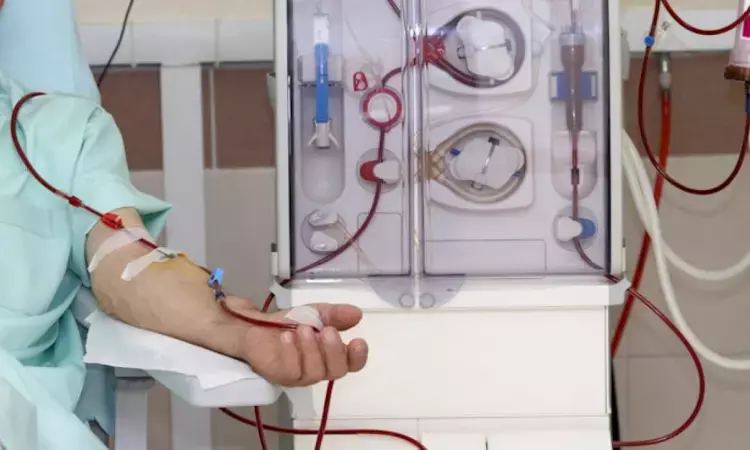- Home
- Medical news & Guidelines
- Anesthesiology
- Cardiology and CTVS
- Critical Care
- Dentistry
- Dermatology
- Diabetes and Endocrinology
- ENT
- Gastroenterology
- Medicine
- Nephrology
- Neurology
- Obstretics-Gynaecology
- Oncology
- Ophthalmology
- Orthopaedics
- Pediatrics-Neonatology
- Psychiatry
- Pulmonology
- Radiology
- Surgery
- Urology
- Laboratory Medicine
- Diet
- Nursing
- Paramedical
- Physiotherapy
- Health news
- Fact Check
- Bone Health Fact Check
- Brain Health Fact Check
- Cancer Related Fact Check
- Child Care Fact Check
- Dental and oral health fact check
- Diabetes and metabolic health fact check
- Diet and Nutrition Fact Check
- Eye and ENT Care Fact Check
- Fitness fact check
- Gut health fact check
- Heart health fact check
- Kidney health fact check
- Medical education fact check
- Men's health fact check
- Respiratory fact check
- Skin and hair care fact check
- Vaccine and Immunization fact check
- Women's health fact check
- AYUSH
- State News
- Andaman and Nicobar Islands
- Andhra Pradesh
- Arunachal Pradesh
- Assam
- Bihar
- Chandigarh
- Chattisgarh
- Dadra and Nagar Haveli
- Daman and Diu
- Delhi
- Goa
- Gujarat
- Haryana
- Himachal Pradesh
- Jammu & Kashmir
- Jharkhand
- Karnataka
- Kerala
- Ladakh
- Lakshadweep
- Madhya Pradesh
- Maharashtra
- Manipur
- Meghalaya
- Mizoram
- Nagaland
- Odisha
- Puducherry
- Punjab
- Rajasthan
- Sikkim
- Tamil Nadu
- Telangana
- Tripura
- Uttar Pradesh
- Uttrakhand
- West Bengal
- Medical Education
- Industry
Cooler dialysate did not substantially lower the likelihood of serious CV events during Hemodialysis : LANCET

Canada: The cluster-randomized MyTEMP study, presented at the American Society of Nephrology Kidney Week and reported in The Lancet, found no cardiovascular (CV) gains from using a cooler dialysate during maintenance hemodialysis.
Hemodialysis centers have traditionally treated all patients to maintenance hemodialysis at a constant dialysate temperature, such as 36°C. For possible cardiovascular benefits, many centers now utilize dialysate that is cooler (e.g., 36°C or lower).
The authors sought to determine whether personalized cooler dialysate, applied as a center-wide policy, decreased the likelihood of hospital admission or death owing to cardiovascular disease.
A pragmatic, two-arm, parallel-group, registry-based, open-label, cluster-randomized superiority trial called MyTEMP was conducted at dialysis facilities in Ontario, Canada.
The medical director of each eligible center had to certify that the center will carry out the designated intervention. Eligible centers required to provide maintenance haemodialysis to at least 15 patients per week. They distributed 84 centers in a 1:1 ratio to either utilize individualized cooler dialysate or standard temperature dialysate (36.5°C for all patients and treatments) using covariate-constrained randomization. Over the course of the 4-year trial, the main composite outcome was cardiovascular-related death or hospital admission with myocardial infarction, ischemic stroke, or congestive heart failure. Analysis was done with the purpose to treat.
Key findings of the trial:
- In comparison to patients who received a standard temperature dialysate (average 36.4°C), patients who received a cooler dialysate temperature (average 35.8°C) did not have a significantly higher risk of a composite outcome of CV-related death or hospital admission with myocardial infarction, ischemic stroke, or congestive heart failure.
- The primary endpoint of the trial was missed because it happened in 21.4% of the group receiving cooler dialysate compared to 22.4% of the group receiving dialysate at room temperature (adjusted HR 1.00, 96% CI 0.89-1.11, P=0.93).
- Throughout the 4-year experiment, there were no differences in any of the various components of the primary composite outcome.
- Systolic blood pressure (BP), a crucial secondary outcome, wasn't significantly impacted by administering a cooler dialysate.
- In the cooler group, the intradialytic systolic blood pressure dropped on average by 26.6 mmHg compared to 27.1 mmHg in the usual temperature group (mean difference -0.5 mmHg, 99% confidence interval -1.4 to 0.4, P=0.14).
- patients weren't satisfied with their customized cooler dialysate because those who received the cooler were much more likely to report feeling extremely cold than those who received the standard temperature (relative risk 1.6, 99% CI 1.1-2.5).
According to Amit Garg, MD, PhD, of Victoria Hospital in London, Ontario, Canada, and colleagues, "this analysis calls into question the growing popularity of cooler dialysate and suggests that future trials should clarify the hazards and advantages of cooler dialysate in particular patient populations."
Although they acknowledged MyTEMP as "impressive," they concluded that its results "should not be taken as definite evidence that cooling the dialysate is unsuccessful for specific patients."
REFERENCE
MyTEMP writing committee "Personalised cooler dialysate for patients receiving maintenance haemodialysis (MyTEMP): a pragmatic, cluster-randomised trial" Lancet 2022; DOI: 10.1016/ S0140-6736(22)01805-0.
Dr Kamal Kant Kohli-MBBS, DTCD- a chest specialist with more than 30 years of practice and a flair for writing clinical articles, Dr Kamal Kant Kohli joined Medical Dialogues as a Chief Editor of Medical News. Besides writing articles, as an editor, he proofreads and verifies all the medical content published on Medical Dialogues including those coming from journals, studies,medical conferences,guidelines etc. Email: drkohli@medicaldialogues.in. Contact no. 011-43720751


